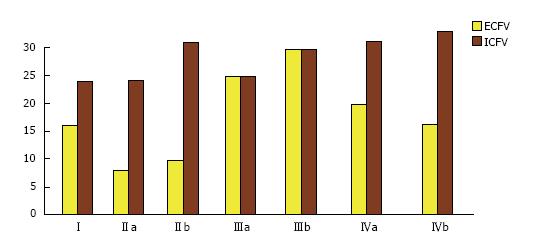Copyright
©The Author(s) 2018.
Figure 1 Body compartment volume (L) in the three categories of hyponatremia.
I: Normal state: ECFV = 16 L, ICFV = 24 L, serum sodium concentration ([Na]S) = 140 mmol/L. II: Hypovolemic hyponatremia; IIa: Loss of 8 L of isotonic sodium solution: ECFV = 8 L, ICFV = 24 L, [Na]S = 140 mmol/L; IIb: Gain of 8 L of water; ECFV = 10 L, ICFV = 30 L, [Na]S = 112 mmol/L. III: Hypervolemic hyponatremia; IIIa: Gain of 8 L of isotonic sodium solution; ECFV = 24 L, ICFV = 24 L, [Na]S = 140 mmol/L; IIIb: Gain of 8 L of water; ECFV = 28 L, ICFV = 28 L, [Na]S = 120 mmol/L. IV: Euvolemic hyponatremia manifested in the syndrome of Inappropriate ADH secretion, which combines water gain and sodium loss[38,39]; IVa: Gain of 8 L of water; ECFV = 19.2 L, ICFV = 28.8 L, [Na]S = 116.7 mmol/L; IVb: Loss of 560 mmol of monovalent sodium salt (e.g., NaCl); ECFV = 16 L, ICFV = 32 L, [Na]S = 105 mmol/L. ECFV: Extracellular fluid volume; ICFV: Intracellular fluid volume.
- Citation: Roumelioti ME, Glew RH, Khitan ZJ, Rondon-Berrios H, Argyropoulos CP, Malhotra D, Raj DS, Agaba EI, Rohrscheib M, Murata GH, Shapiro JI, Tzamaloukas AH. Fluid balance concepts in medicine: Principles and practice. World J Nephrol 2018; 7(1): 1-28
- URL: https://www.wjgnet.com/2220-6124/full/v7/i1/1.htm
- DOI: https://dx.doi.org/10.5527/wjn.v7.i1.1









